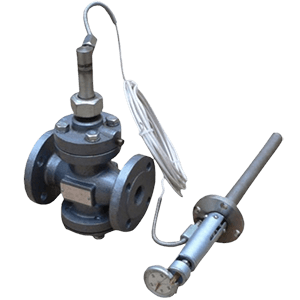Introduction: Why Temperature Control Is Essential
From HVAC systems in buildings to industrial automation, laboratory equipment, food processing, and valve applications, temperature control systems are everywhere. They’re responsible for keeping environments comfortable, products consistent, and machines running within safe limits.
But how does temperature control actually work? What makes a system sense a temperature change and adjust accordingly? Let’s explore the fundamentals of automatic temperature regulation, and how this seemingly invisible process plays a crucial role in modern technology.
The Basic Working Principle of Temperature Control
At its core, temperature control is about measuring current temperature, comparing it to a set target, and then taking action to correct any difference (called the “error”).
The basic steps are:
-
①Measurement – A sensor (like a thermocouple or RTD) detects the current temperature.
-
②Comparison – A controller compares the measured value to the desired setpoint.
-
③Correction – The system activates heating or cooling equipment to reduce the error.
-
④Feedback Loop – Continuous adjustments are made to maintain the target temperature.
Components of a Temperature Control System
-
Temperature Sensor
-
①Common types: thermocouples, RTDs, thermistors
-
②Function: Measure the actual temperature of the process or environment.
-
-
Controller
-
①Electronic device or software logic that uses algorithms like PID (Proportional-Integral-Derivative) to determine how much adjustment is needed.
-
②Outputs a signal to the actuator.
-
-
Actuator/Control Element
-
①Devices like heaters, coolers, temperature control valves, or fans that adjust the temperature.
-
-
Setpoint Input
-
①The target temperature manually entered or automatically set via software.
-
-
Feedback Mechanism
-
①Ensures that real-time measurements guide system responses continuously.
-
How PID Temperature Control Works
The PID controller is the most widely used algorithm in industrial temperature control because of its accuracy and responsiveness.
-
①Proportional: Adjusts the output based on the size of the error.
-
②Integral: Eliminates residual errors by accounting for the sum of past errors.
-
③Derivative: Predicts future errors based on the rate of change.
Industrial Applications of Temperature Control
-
①HVAC Systems – Maintain indoor comfort by adjusting air temperature automatically.
-
②Injection Molding – Precise mold temperature improves product quality.
-
③Food & Beverage – Maintain safe cooking, pasteurization, or storage temperatures.
-
④Chemical Processing – Ensure reactions occur at optimal thermal conditions.
-
⑤Power Plants – Manage turbine and boiler temperatures for safety and efficiency.
-
⑥Valve Industry – Use temperature control valves to regulate fluid temperatures in pipelines.
Smart and Digital Temperature Control
With the rise of IoT (Internet of Things) and smart manufacturing, temperature control has become more advanced:
-
①Digital temperature controllers with touchscreen interfaces
-
②Remote monitoring via cloud-based platforms
-
③Self-learning systems that adapt to environmental changes
-
④Wireless sensors in distributed temperature control networks
What Happens Without Proper Temperature Control
-
①Overheating can damage equipment, spoil materials, or cause fires.
-
②Underheating may lead to incomplete processes or poor product quality.
-
③Temperature instability causes fluctuations in performance, energy waste, and safety risks.
Whether it’s an HVAC unit, diesel engine, pharmaceutical production line, or butterfly valve system, temperature control ensures reliability, longevity, and efficiency.
Post time: Jul-30-2025

